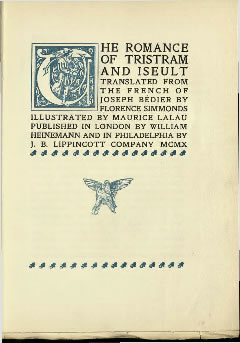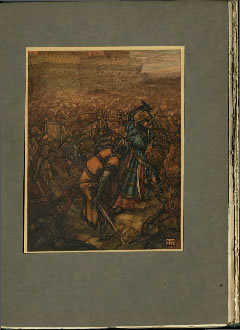The Romance of Tristram and Iseult
You may click on the thumbnail images to view them full screen
Author: Joseph Bédier
Translator: Florence Simmonds
Title: The Romance of Tristram and Iseult
Illustrations: Maurice Lalau
Year: 1910
Publisher: London: William Heinemann; Philadelphia: J.B. Lippincott Company
Price: 15 shillings
Few Arthurian books published in the twentieth century have captured the public imagination with quite so much avidity as French scholar Joseph Bédier's masterly edition of the twelfth-century French romance, Le Roman de Tristan et Iseut. First published in 1900 for a popular rather than academic audience, the tragically romantic tale of Tristan et Iseult soon came to inhabit, as was Bédier's intention, its place among the finest works of French national literature. Such was the books success in France that Bédier's adaptation of the Tristan legend soon found an equally receptive audience on the other side of the Channel, in Britain. Translated into English in 1903 by Hilaire Belloc, himself a prolific Anglo-French scholar, The Romance of Tristan and Iseult is widely credited for introducing medieval legend to the general population, and inspired a number of other translations and adaptations of medieval Arthurian literature.
Housed in Bangor University's Centre for Arthurian Studies, Florence Simmonds' 1910 English translation of Bedier's Tristan et Iseult is one of the more exquisite examples of early twentieth-century Arthurian printed books. Faithfully translated from the original French, Simmonds, unlike Belloc's earlier translation, showed her appreciation for the original by printing a translation of both Bédier and Gaston Paris's prefaces to the first edition, albeit slightly bowdlerized; Simmonds' translation also differs from Belloc's in that it includes all nineteen of Bédier's original chapters. It is Maurice Lalau's beautifully rendered colour plates, however, which elevate the text to further prominence. Produced using a technique called Pochoir, in which a series of stencils are employed to create a distinctive three-dimensional appearance, Lalau's images, and his technique, was much in fashion in early twentieth-century France, and proved particularly popular with the art nouveau and art deco scene. Although intended for an English-language reader, Simmond's version of the text retains a uniquely French feel: through her careful translation of the text, her printing of the original prefaces, and through the thoroughly French influenced designs of Maurice Lalau, Simmonds's Romance of Tristram and Iseult captures the essence of why Arthurian books were so appealing to both French and British readers in the early twentieth century.

Title page: The Romance of Tristram and Iseult, 1910
Nearly six-hundred editions of Bedier's Tristan et Iseult have been printed in English since the first translation in 1903

'The
castle rose by the sea coast, fair and strong'

'Then the two on foot, with shattered shields and hauberks unbuckled, defied and assailed each other'